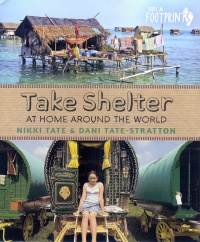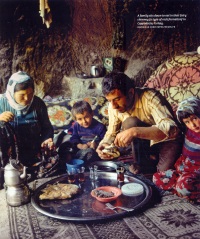| ________________
CM . . .
. Volume XXI Number 6. . . .October 10, 2014 
 |
Take Shelter: At Home Around the World.
Nikki Tate & Dani Tate-Stratton.
Victoria, BC: Orca, 2014.
48 pp., hardcover, pdf & epub, $19.95 (hc.).
ISBN 978-1-4598-0742-6 (hc.), ISBN 978-1-4598-0743-3 (pdf), ISBN 978-1-4598-0744-0 (epub).
Subject Headings:
Dwellings-Juvenile literature.
Architecture, Domestic-Juvenile literature.
Grades 3-7 / Ages 8-12.
Review by Sherry Faller.
***½ /4
Reviewed from f&gs.
|
| |
|

excerpt:
From sprawling mansions to precarious cliff dwellings, the variation in what we humans call home is staggering. Humans have always experimented with different building materials like straw, reeds, clay, concrete, brick, glass, and modern composite materials like carbon fiber.
Take Shelter is a collection of the many ways that people have made their homes in the past and how they live now. Homes from around the world are described in detail, and colourful photos showcase even more examples. Divided into four sections, the book covers homes in the ground, homes that can be moved, the materials used to build the homes, and finally uniquely creative homes.
 Homes in the ground include caves, dug-outs, bomb shelters and even storm tunnels that are inhabited by the homeless in big cities. Homes that can be moved include tipis, igloos and yurts. Caravan wagons, house boats, cruise ships and motor homes can serve as temporary or permanent homes. Homes in the ground include caves, dug-outs, bomb shelters and even storm tunnels that are inhabited by the homeless in big cities. Homes that can be moved include tipis, igloos and yurts. Caravan wagons, house boats, cruise ships and motor homes can serve as temporary or permanent homes.
Many homes are built using readily attained materials, such as the mud/dung homes in Africa and India. Some houses have thatched roofs using local grasses, and some are built on stilts to accommodate the frequently flooded surroundings. Keeping homes warm also is accomplished creatively, using fiberglass, fleece, or even corn cobs.
The section on creative homes discusses how people have used ingenuity to create a space in which to live. Is a space station a home for astronauts? Yes! Can people live in a dumpster? Dress it up, and you can call it home. Communal groups work together for the common good, and communities build together to help others in need. Habitat for Humanity is one such collective group that builds homes for the needy.
Both authors have inhabited many different kinds of homes. Throughout the pages, the reader will find small departures that are entitled ‘My Place’. The authors give a personal account of their experiences with tree houses, a pigeon coop, a root cellar, playhouses, hostels in a castle and a sanctuary in an eco-village.
Scattered throughout Take Shelter are short editorials called ‘Home Facts’ that offer additional information that may amaze. For example, “The little chimney that vents smoke from the inside of a Romany’s wagon is always on the right side of the roof. That way, the chimney is less likely to be damaged by a low branch along the left side of the road, as is usual in Great Britain.”
Take Shelter is a perfect resource for any student learning about homes around the world. The text is both interesting and well-researched. The writing style is straightforward and filled with appealing tidbits. All the photos include descriptive captions. Similar to the other books in the “Orca Footprints” collection, this book is formatted with an index, contents and a resource section that includes several websites for further research. Every school library will want this informative book.
Highly Recommended.
Sherry Faller is a retired teacher-librarian in Winnipeg, MB.

To comment
on this title or this review, send mail to cm@umanitoba.ca.
Copyright © the Manitoba Library Association. Reproduction for personal
use is permitted only if this copyright notice is maintained. Any
other reproduction is prohibited without permission.
Next Review
| Table of Contents For This Issue - October 10, 2014.
CM Home | Back Issues
| Search
| CM Archive
| Profiles Archive
|

 Homes in the ground include caves, dug-outs, bomb shelters and even storm tunnels that are inhabited by the homeless in big cities. Homes that can be moved include tipis, igloos and yurts. Caravan wagons, house boats, cruise ships and motor homes can serve as temporary or permanent homes.
Homes in the ground include caves, dug-outs, bomb shelters and even storm tunnels that are inhabited by the homeless in big cities. Homes that can be moved include tipis, igloos and yurts. Caravan wagons, house boats, cruise ships and motor homes can serve as temporary or permanent homes.